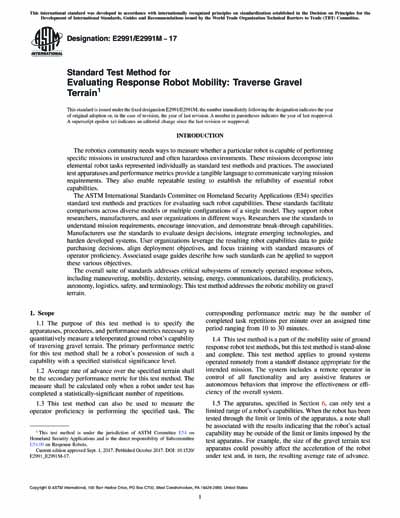Most recent
ASTM E2991/E2991M-17
Standard Test Method for Evaluating Response Robot Mobility: Traverse Gravel Terrain
1.1 The purpose of this test method is to specify the apparatuses, procedures, and performance metrics necessary to quantitatively measure a teleoperated ground robot’s capability of traversing gravel terrain. The primary performance metric for this test method shall be a robot’s possession of such a capability with a specified statistical significance level.
1.2 Average rate of advance over the specified terrain shall be the secondary performance metric for this test method. The measure shall be calculated only when a robot under test has completed a statistically-significant number of repetitions.
1.3 This test method can also be used to measure the operator proficiency in performing the specified task. The corresponding performance metric may be the number of completed task repetitions per minute over an assigned time period ranging from 10 to 30 minutes.
1.4 This test method is a part of the mobility suite of ground response robot test methods, but this test method is stand-alone and complete. This test method applies to ground systems operated remotely from a standoff distance appropriate for the intended mission. The system includes a remote operator in control of all functionality and any assistive features or autonomous behaviors that improve the effectiveness or efficiency of the overall system.
1.5 The apparatus, specified in Section 6, can only test a limited range of a robot’s capabilities. When the robot has been tested through the limit or limits of the apparatus, a note shall be associated with the results indicating that the robot’s actual capability may be outside of the limit or limits imposed by the test apparatus. For example, the size of the gravel terrain test apparatus could possibly affect the acceleration of the robot under test and, in turn, the resulting average rate of advance.
1.6 Performing Location—This test method may be performed anywhere the specified apparatuses and environmental conditions can be implemented.
1.7 Units—The values stated in either SI units or inch-pound units are to be regarded separately as standard. The values stated in each system may not be exact equivalents; therefore, each system shall be used independently of the other. Combining values from the two systems may result in nonconformance with the standard. Both units are referenced to facilitate acquisition of materials internationally and minimize fabrication costs.
1.8 This standard does not purport to address all of the safety concerns, if any, associated with its use. It is the responsibility of the user of this standard to establish appropriate safety, health, and environmental practices and determine the applicability of regulatory limitations prior to use.
1.9 This international standard was developed in accordance with internationally recognized principles on standardization established in the Decision on Principles for the Development of International Standards, Guides and Recommendations issued by the World Trade Organization Technical Barriers to Trade (TBT) Committee.
ASTM International [astm]

